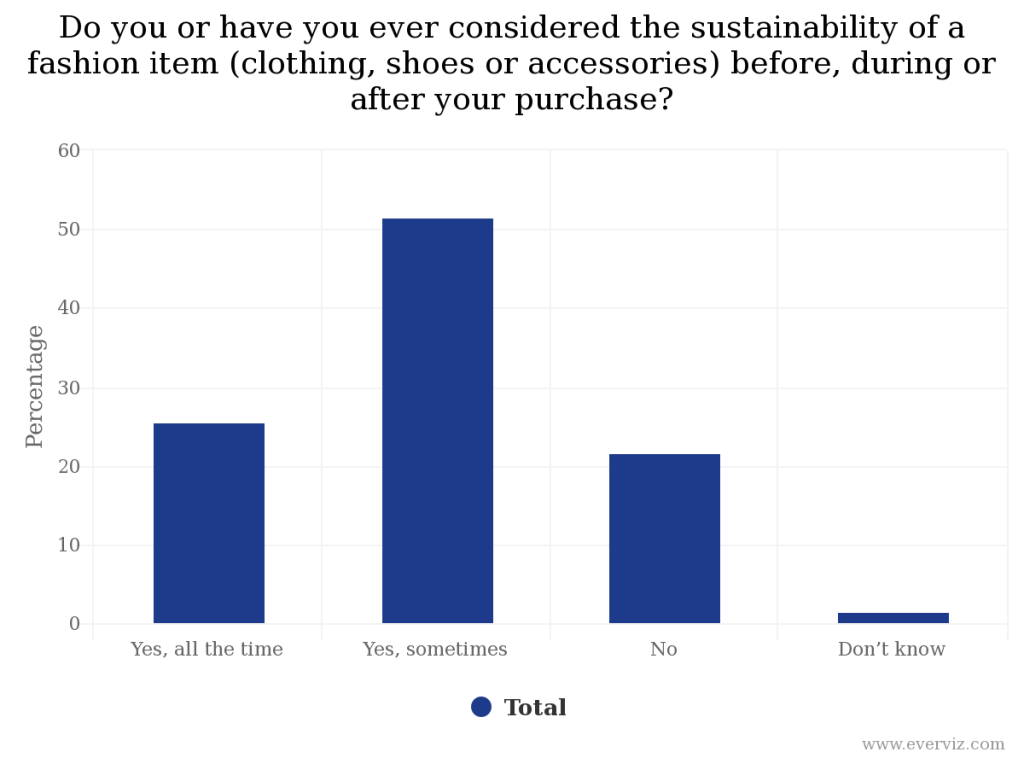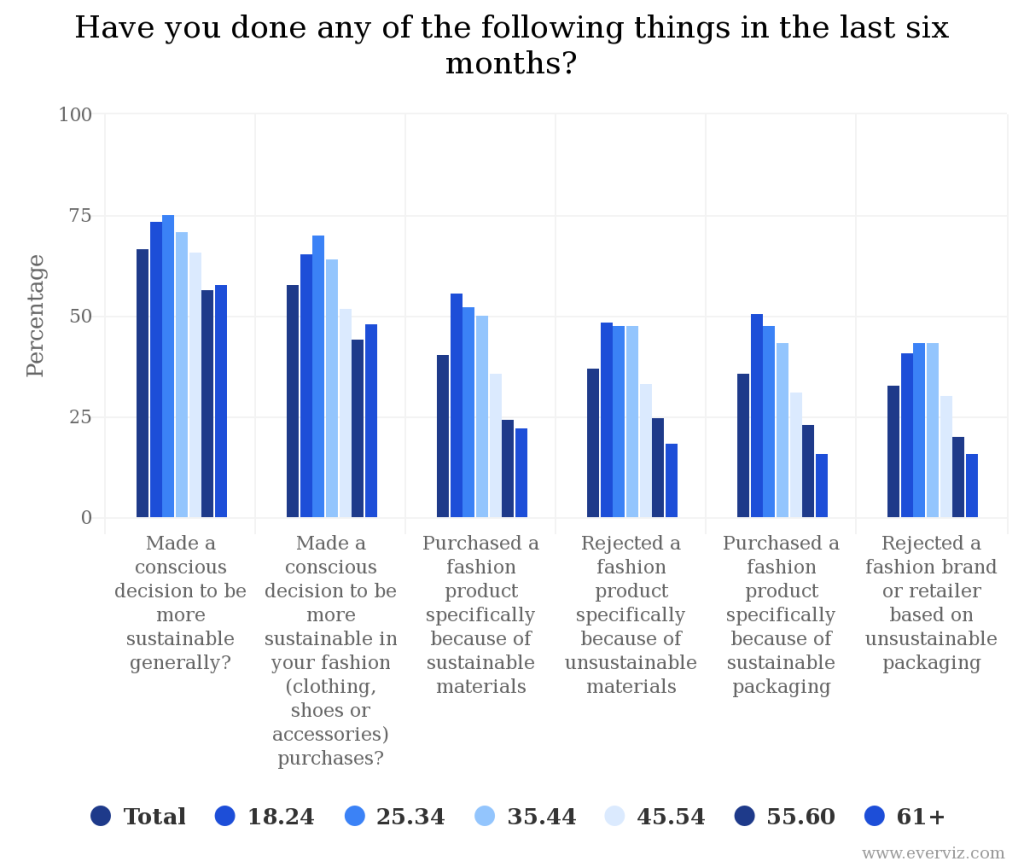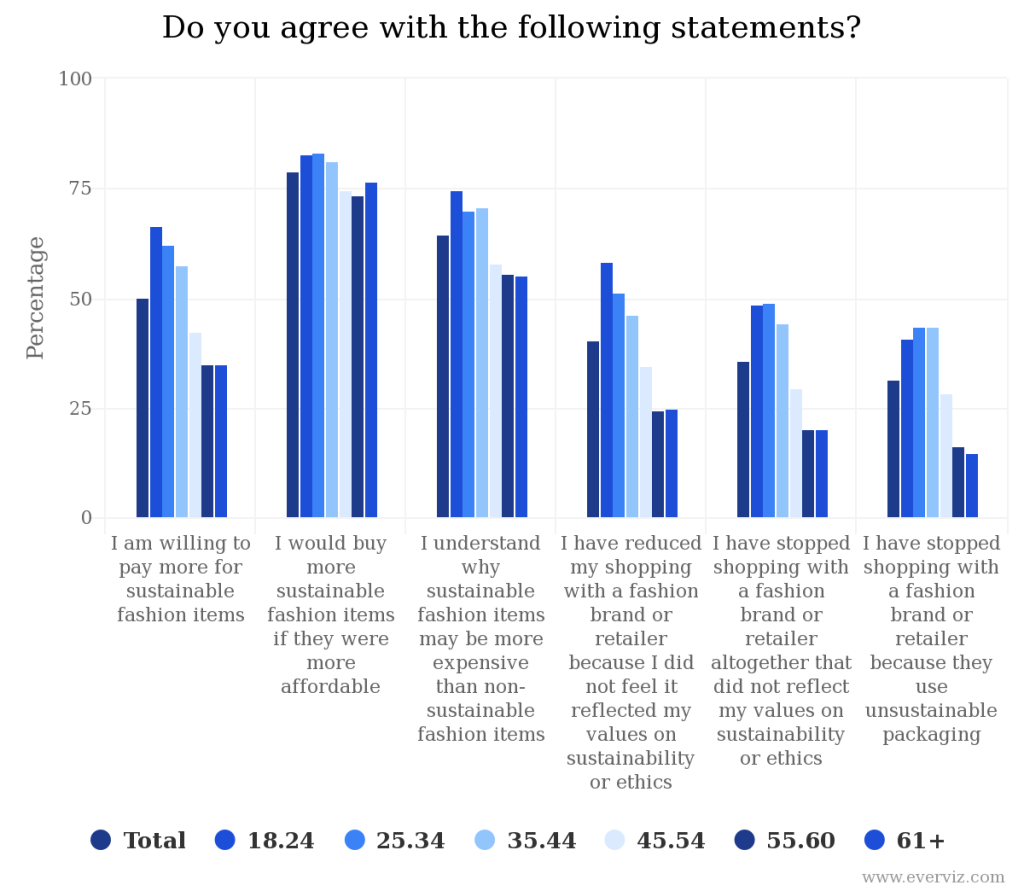A survey by Drapers has revealed that sustainability plays a significant role in consumers’ purchasing decisions, with 64% of respondents indicating a higher likelihood of making a purchase if the product’s packaging is sustainable.
The Drapers Sustainability and the Consumer report for 2022 provides insights into consumer attitudes, preferences, and priorities in the fashion industry, particularly concerning sustainability.
This survey, based on responses from 2,000 UK consumers, explores the changing sustainability perspectives among shoppers and their influence on fashion-buying behavior. The participants, spanning ages from 18 to 61+, were evenly distributed across various age groups.
The survey highlights a growing awareness of sustainability among shoppers, with 77% stating that they now consider sustainability when making fashion purchases, either consistently or occasionally. This indicates a slight increase from 2021 when 75% reported some degree of consideration.

Notably, 92% of respondents aged 18 to 24 prioritize sustainability when buying fashion. The desire for sustainable fashion shopping is particularly strong among those under 35, with 70% of 25-to-34-year-olds expressing a commitment to environmentally conscious fashion purchases.

One standout finding is that a significant 64% of respondents are more inclined to purchase from a fashion brand or retailer if they perceive the packaging as sustainable. Similarly, 63% prefer brands that offer sustainable delivery options. However, it’s important to note that 51% of participants are unwilling to pay extra for sustainable packaging.
Digging deeper into consumer behaviour, 36% and 33% of respondents indicate that they have chosen a retailer because of its sustainable packaging practices or rejected one due to unsustainable packaging choices, respectively. Moreover, 41% of participants claim to have purchased a product specifically because it features sustainable materials. Among the 18-to-24-year-old demographic, this percentage rises to 56%.
These findings underscore the importance of sustainable packaging for brand loyalty, as nearly a third of all respondents (32%) reveal that they’ve stopped shopping with a brand due to unsustainable packaging practices. This percentage climbs to 43% for individuals aged 25 to 34.

Eddie Fellows, the Chief Executive of Smurfit Kappa in the UK and Ireland, points out that packaging provides an accessible starting point for retailers looking to enhance their environmental efforts. He notes that there’s ample room for improvement, such as eliminating excess space in e-commerce packaging, transitioning to paper-based materials instead of non-recyclable options, and optimizing supply chains.
The survey findings also highlight the importance of labels and packaging as sources of information for consumers. An overwhelming 73% of respondents rely on product labels, while 69% refer to information and symbols on product packaging. This suggests that retailers have an opportunity to use these platforms to effectively communicate their progress in sustainability and future endeavours. Utilizing QR codes or web addresses could guide curious consumers to relevant sites or apps for further information.
What actions should retailers take to cater to the growing eco-awareness of customers:
Offer Sustainable Packaging Options: Provide customers with choices for sustainable packaging materials. This can include options like recyclable, compostable, or reusable packaging. Clearly communicate the environmental benefits of these choices to customers. For example, Myerton Packaging has always been working hard to introduce innovative sustainable packaging materials to clients. Through continuous innovation, we have developed an extensive eco-packaging range including moulded fibre inserts, gift boxes, Crush agro-waste paper packaging, kerbside recyclable packaging , NatureFlex home compostable packaging, etc. Discover more about our eco-friendly solutions here.
Educate Customers: Create informative content about the sustainability of your products and packaging. This can be done through blog posts, social media, or labels on products. Explain how sustainable choices benefit the environment and why they matter.
Reduce Packaging Waste: Minimize excess packaging and use materials that are easily recyclable. Consider innovative packaging designs that use less material while still protecting products during shipping and handling.
Highlight Eco-Friendly Certifications: If your products or packaging have received certifications like FSC (Forest Stewardship Council), recyclable, or compostable labels, prominently display these on your packaging. Customers often look for these certifications as a sign of sustainability.
Transparency: Be transparent about your supply chain and sourcing practices. Customers want to know where and how products are made. Share information about ethical sourcing, fair labor practices, and responsible manufacturing.
